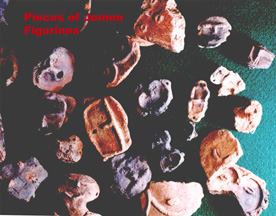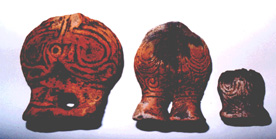| Late Jomon |
|
|
|
Compared to the preceding Middle Jomon period, a number of changes are evident in the archaeological record for the Late Jomon period. The most striking change is in the number of settlements. For the Kanto and Chubu regions it is particularly marked, going from several thousands of sites in the Middle Jomon period to just more than two thousand in the succeeding Late Jomon period. In the Kanto region, during the Late and Final Jomon periods, there is a trend towards riverine and coastal settlements that exploited a variety of marine resources. The Late Jomon period sees a rise in ritual activity also. Throughout Japan, burials became more numerous. A tradition of building small stone circles also begins in eastern and northern Japan. Ritual artifacts, such as stone rods, stone phalli, and figurines, also increase in number during the Late and Final Jomon periods.
Above are some more examples of Jomon figurines^ While carving and sculpting decorative shapes into the clay was popular during the Middle Jomon period, the Late Jomon period sees a return to using cord-marking and incising lines for decorating pottery. Erased cord-marking (surikeshi jomon) is developed at this time. In this decorative scheme, cord-marking is applied and then portions of it are erased to create a smooth surface. Firing pottery in a reducing atmosphere is also developed at this time. Some of the more famous pottery styles from this sub-period are Goryo, Horinouchi, and Kasori B styles.
|
||


 English (UK)
English (UK)  Ру́сский
Ру́сский  中文
中文  Portugues
Portugues  한국어
한국어  Espanol
Espanol  Deutsch
Deutsch